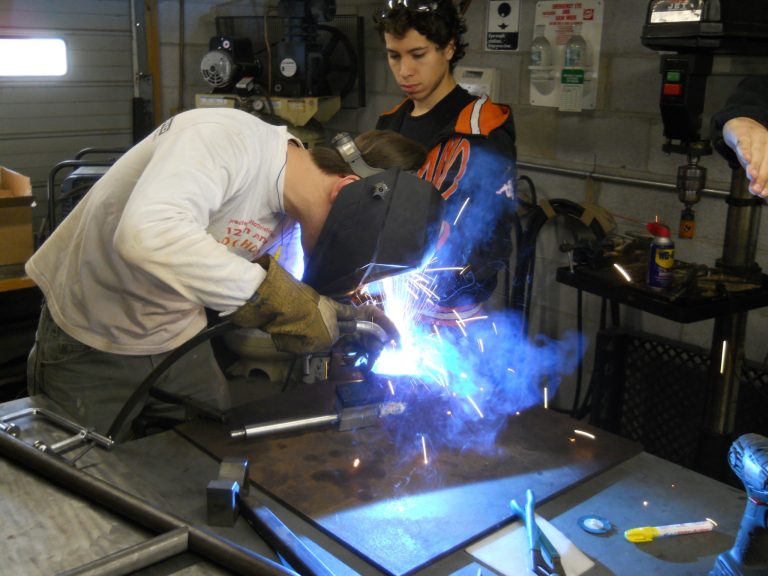
This growth is projected to continue until at least 2021. When combined with the ongoing investments in infrastructure, industry and commercial expansion in many world markets, it also means the demand for engineers will continue to progress.
Of course with this promising future comes serious competition, thus graduates from the best engineering universities will reap the greatest rewards. North American engineering universities offer high quality engineering degrees, making them ideal places for international or American students to study.

Image via Hofstra University
Studying at an American university is also an easier pathway to employment within the U.S. While the international job market for engineering is promising, engineers are also some of the highest paid in the United States.
According to the Bureau of Labor Statistics for the United States Department of Labor, the median annual wage for architecture and engineering occupations was $76,870 in 2015, compared to $36,200 in the general economy.
The Bureau of Labor also projected a growth of three percent in architecture and engineering occupations from 2014 to 2024. This is expected to add about 67,200 new jobs to the market and some areas of engineering in the U.S. only require a bachelor’s degree for an entry level position.
While these statistics, job opportunities and compensation do make engineering a popular field of study, it is also a highly challenging subject area. High level maths and science is required and the practical knowledge to design, build and problem solve.

Image via Lipscomb University
The rewards however, are enormous. Engineers are a key driver of human development and “behind the cars we drive, the pills we pop and the way we power our homes”, as the British inventor James Dyson said.
Famous engineers include the respected American industrialist and car manufacturer Henry Ford, astronaut Neil Armstrong and even the business entrepreneur Elon Musk of PayPal fame. Their array of achievements shows just how diverse, as well as financially and intrinsically rewarding the study of engineering can be.
Musk continually emphasises the importance of engineering in our world, claiming that solving engineering and manufacturing problems has been part of his success: “The path to the CEO’s office should not be through the CFO’s office, and it should not be through the marketing department. It needs to be through engineering and design.”
Study fields in the U.S. include chemical, agricultural, environmental, electro-mechanical, industrial, health and safety, aerospace, biomedical, cartography, electrical, computer and civil engineering.

Image via Embry-Riddle Aeronautical University
To become part of this extraordinary and rewarding field, consider some of these leading North American engineering universities:
RAYMOND B. JONES COLLEGE OF ENGINEERING, LIPSCOMB UNIVERSITY – NASHVILLE
Lipscomb University, located in Tennessee’s capitol city of Nashville, is consistently a top-ranked university renowned for its academic rigor and spiritual growth. It is home to the highly acclaimed Raymond B. Jones College of Engineering with three undergraduate degrees accredited by the Engineering Accreditation Commission of ABET. The College has thriving undergraduate programs in civil, electrical and computer, and mechanical engineering.
An important feature that sets Lipscomb’s engineering programs apart is a fundamental value that engineering is about making people’s lives better; courses therefore combine academics with a sensitivity to people and their needs. Included are many opportunities for practical, real-world applications as student groups travel abroad to places like Guatemala, Honduras and Haiti to assist in hands-on engineering projects such as building bridges, developing solar power, and constructing water systems.
At Lipscomb, students experience small classes where they receive individual attention from knowledgeable and accomplished faculty. Industry professionals also have reported that the alumni are well prepared to contribute in engineering roles upon graduation.
The results speak for themselves – graduates are employed at some of the top engineering companies in the world, and others are accepted to U.S. engineering graduate schools of their choice.

Image via Lipscomb University
COLLEGE OF ENGINEERING, EMBRY RIDDLE UNIVERSITY – FLORIDA
Embry-Riddle Aeronautical University in Daytona Beach, Florida is renowned as the nation’s largest educator of aerospace engineers and is indeed a special place for those with a passion for this field. But it also has undergraduate and graduate programs in mechanical, civil and software engineering and engineering fundamentals.
Embry-Riddle’s success lies in a teaching methodology that combines theory in the classroom with the opportunity to do hands-on work. In this way students learn from day one to design, build and see a project through to fruition. Classes are kept small for better interaction with teachers, and the combination of theory and practice has seen six graduates become NASA astronauts and the courses recognized as producing engineers ready to solve real-world problems.
COLLEGE OF ENGINEERING AND COMPUTER SCIENCE, WRIGHT STATE UNIVERSITY – OHIO
The College of Engineering and Computer Science is dedicated to preparing its graduates to advance the frontiers in an array of disciplines including biomedical, computer, aerospace, mechanical and industrial engineering. Both Bachelor’s, Master’s and Degree programs are offered at Wright State and laboratory projects often combine an array of all levels of students so they can learn from each other under the direction of experienced faculty members.
Amongst the benefits of studying at Wright State are its low-cost, high-value programs and proximity to the Air Force Research Laboratory at Wright-Patterson Air Force Base in Dayton, Ohio. This “birthplace of aviation” is also home to research laboratories that afford Wright students opportunities in cyber science and sensors, autonomous systems and advanced manufacturing.

Image via Hofstra University
SCHOOL OF ENGINEERING AND APPLIED SCIENCE, HOFSTRA UNIVERSITY – NEW YORK
Hofstra University’s School of Engineering and Applied Science (SEAS) offers courses in mechanical, electrical, industrial, civil, biomedical, and computer engineering primarily at the undergraduate level. Students are given hands-on access to sophisticated technology that may include anything from a 3D-printer to an atomic force microscope, supersonic wind tunnel or robotics laboratory so they can actually test the theories they learn inside the classroom. Qualified students also have the opportunity to work in companies that utilize engineering skills for a suitable salary before they return to complete their degree.
SEAS is committed to small class sizes and the accessibility of its professors who act not just as teachers but also mentors to best prepare them for professional careers or continued study at the graduate level.
COLLEGE OF ENGINEERING, MERCER UNIVERSITY – GEORGIA
The courses at Mercer University School of Engineering are designed to prepare students to serve the rapidly changing demands of the modern world. Courses focus on practical work experience, international study, community service and research so students are best equipped to enter the workplace with highly employable skills.
Mercer students are taught within a small, close-knit learning environment and encouraged to compete in national engineering competitions, attend societal conferences and showcase their work as much as possible in forums such as the National Engineering Advisory Board meetings. They are also encouraged to participate in year-long projects for clients in industry.
Undergraduate and graduate degrees are offered in fields such as biomedical, computer, electrical, environmental, industrial and mechanical engineering.
Main image via Lipscomb University
Liked this? Then you’ll love these…
21 things only engineering students will understand
Engineering Your Future: Why Study a Masters in Engineering?












